

<< Go Back up to Region ‘Los Angeles: Hollywood’
| Follow Mike Hume’s Historic Theatre Photography: |  |
 |
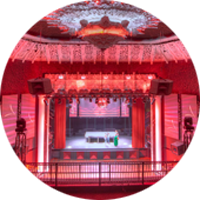
Architects: Gogerty and Weyl
First Opened: 24th January 1927 (98 years ago)
Former Names: Hollywood Playhouse, El Capitan Theatre, Jerry Lewis Theatre, ABC’s Hollywood Palace
Status: Nightclub / Live events venue
Website: avalonhollywood.com 
Telephone: (323) 462-8900 
Address: 1735 Vine Street, Los Angeles, CA 90028 
Originally opened as the Hollywood Playhouse in 1927, the theatre was the last of four major legitimate theatres to open in Hollywood in relatively quick succession. During the 1950s, 60s, and 70s, the building was the U.S. West Coast’s best-known television theatre, broadcasting shows such as “The Bob Hope Show”, “The Hollywood Palace”, and “The Jerry Lewis Show”. It is now a popular live entertainment venue called Avalon Hollywood.

 Detailed Information
Detailed Information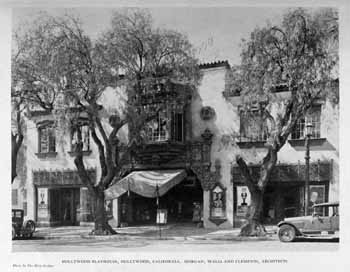
The Hollywood Playhouse opened on 24th January 1927 and was the fourth legitimate theatre to open in Hollywood in the space of nine months. It followed the openings of the El Capitan Theatre in May 1926, the Music Box (now Fonda) Theatre in October 1926, and the Vine St (now Ricardo Montalbán) Theatre in mid-January 1927.
Architects Henry L. Gogerty and Carl J. Weyl designed the theatre in a Spanish Baroque style, although upon closer inspection some elements go beyond Spanish Baroque into Churrigueresque. Gogerty and Weyl would go on to design a number of schools and commercial buildings, including Gogerty’s design of the Grand Central Air Terminal in Glendale, however it appears the Hollywood Playhouse was the only theatre designed by either architect. Interior decoration was by Steffan Horbaczek. Horbaczek had previously worked on the Metropolitan/Paramount Theatre in downtown Los Angeles (opened four years prior), and was a scene painter for the Los Angeles Grand Opera Association.
Following the successes enjoyed during the mid- to late-1920s, the Depression hit at the start of the 1930s. By 1935 the Works Progress Administration (WPA) established the Federal Theatre Project (FTP), its primary goal being the employment of out-of-work artists, writers, and directors, with the secondary aim of entertaining poor families and creating relevant art. The Hollywood Playhouse became the WPA Federal Theatre and played host to many FTP projects. Another FTP theatre in Los Angeles at the time was the Belasco Theatre in downtown L.A.
In mid-February of 1942 the theatre was bought by Charles Toberman for $105,000, with Sid Grauman buying a 50% share of Toberman’s new venture, and the theatre’s name was changed to the El Capitan Theatre (Hollywood’s original El Capitan Theatre, built by Toberman in 1926, had just been long-term-leased by Toberman and had started operating as the Hollywood Paramount). Toberman arranged for stage equipment to be transferred from the old El Capitan to the new El Capitan. The initial production, Ken Murray’s variety show called “Blackouts of 1942”, was received favorably and led to a seven year run of “Blackouts” shows.
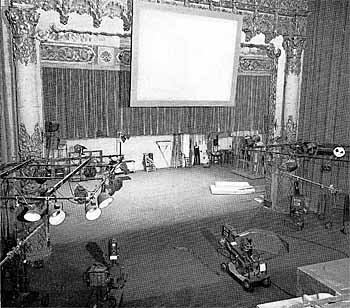
In 1949 CBS offered Ken Murray a television show but stipulated that it had to be broadcast from New York. Thus ended the long run of the “Blackouts” shows, and Charles Toberman sold the theatre to the Catholic church, who in turn leased the building to NBC. NBC initially stuck with the El Capitan name, or at least that is how it was commonly referred to, but by 1952 it was firmly branded as an NBC Television location.
The Los Angeles Times reported rumors of NBC’s interest in buying the theatre as early as February 1951, however the rumors were rebuffed by engineers who said that the theatre was “not quite suitable for big-scale TV operations since it has no back entrance for scenery shifts and storage”. A month later, in late March 1951, the newspaper reported that the theatre had been sold “presumably to NBC” and would likely become a television house. By mid-September the newspaper reported that NBC was planning a $1 million renovation job on the theatre.
The first show to be broadcast from NBC’s newest studio was The Colgate Comedy Hour, starring Eddie Cantor et al, on 30th September 1951. The opening of the show utilized establishing shots of Hollywood & Vine with the hosts walking up the street to the theatre and through its entrance doors. Hollywood had firmly established itself on television.
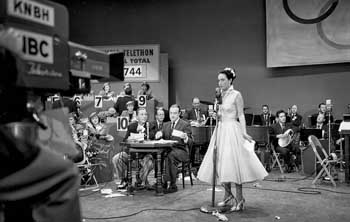
Hot on its heels was The Bob Hope Show broadcast on Sunday 14th October 1951. In mid-June 1952 the first coast-to-coast telethon was held at the theatre; a star-studded 14.5 hour event to raise money for the US Olympics Team.
On 23rd September 1952 Richard Nixon broadcast his famous “Checkers” speech from the theatre. At his request the sole audience member in the theatre was his wife, however the half-hour speech was broadcast across the nation and was heard or seen by some 60 million Americans.
In 1963 ABC purchased the theatre and, following a $400,000 renovation, renamed it the Jerry Lewis Theatre with it becoming the home of the The Jerry Lewis Show from September 1963. The success of the show was short-lived and it was replaced by a one-hour variety show: The Hollywood Palace, which started its run on 4th January 1964. The show went on to run for over six years and featured the U.S. television début of the Rolling Stones and the first national network appearance of the Jackson 5. The 25th February 1967 edition featured the U.S. television debut of the Beatles’ music videos for “Penny Lane” and “Strawberry Fields Forever”.
In the early 1970s the theatre hosted the Merv Griffin Show for several years, however after the show moved-out the theatre went dark until 1978 when ABC sold the theatre to businessman Dennis Lidtke, who reopened as the Palace. The Palace became one of the most popular music and nightclub venues in Hollywood, with a five-night-a-week mega dance club featuring the largest light and sound system in Los Angeles; the self-proclaimed West Coast version of New York’s infamous Studio 54.
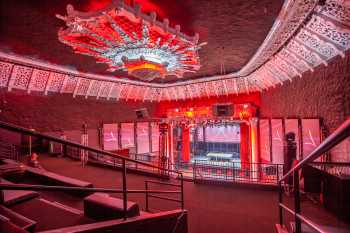
Prince, Madonna, the Rolling Stones, and Olivia Newton John are just a few of the famous names to have appeared at the Palace. In the 1990s ownership changed but the commitment to live music remained. Bands such as Nirvana, Smashing Pumpkins, The Beastie Boys, and Nine Inch Nails headlined at the theatre.
In 2002 the theatre was purchased by Hollywood Entertainment Partners (John Lyon and Steve Adelman) who already operated successful “Avalon” clubs in Boston and New York. Time has shown they were adept at replicating the phenomenon created in Boston and New York, as Avalon Hollywood has been going strong for nearly 20 years and continues to be at the forefront of premier live entertainment and music in Hollywood as we enter the 2020s.
 Movie, TV & Music Video Appearances
Movie, TV & Music Video Appearances . Interior of the nightclub “Jake’s Palace”.
. Interior of the nightclub “Jake’s Palace”. . Aerial views.
. Aerial views. . Interior of the “Ritz” nightclub.
. Interior of the “Ritz” nightclub.






 Video from our YouTube channel:
Video from our YouTube channel: Listed/Landmark Building Status
Listed/Landmark Building Status (4th April 1985)
(4th April 1985) How do I visit the Avalon Hollywood?
How do I visit the Avalon Hollywood?As of early 2020 Avalon Hollywood does not offer tours however the varied range of live events they run every week is on their events calendar  .
.
 Further Reading
Further Reading boasts a comprehensive history of the theatre featuring a wealth of photos of the theatre through the years, as well as some original building plans.
boasts a comprehensive history of the theatre featuring a wealth of photos of the theatre through the years, as well as some original building plans. contains further information including a history page, calendar of events, and online ticketing.
contains further information including a history page, calendar of events, and online ticketing. , by Tom Ogden, published by Globe Pequot. ISBN 149301577X.
, by Tom Ogden, published by Globe Pequot. ISBN 149301577X. , by Gregory Paul Williams, published by BL Press. ISBN 0977629929.
, by Gregory Paul Williams, published by BL Press. ISBN 0977629929. Photos of the Avalon Hollywood
Photos of the Avalon HollywoodPhotographs copyright © 2002-2025 Mike Hume / Historic Theatre Photos unless otherwise noted.
Text copyright © 2017-2025 Mike Hume / Historic Theatre Photos.
For photograph licensing and/or re-use contact us here  . See our Sharing Guidelines here
. See our Sharing Guidelines here  .
.
| Follow Mike Hume’s Historic Theatre Photography: |  |
 |